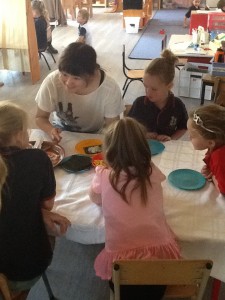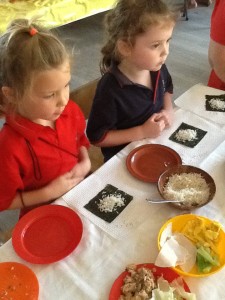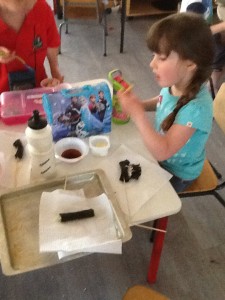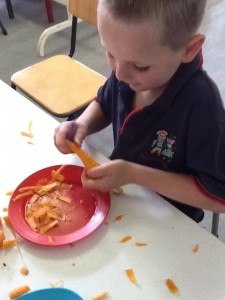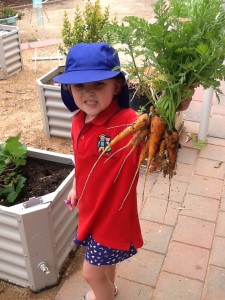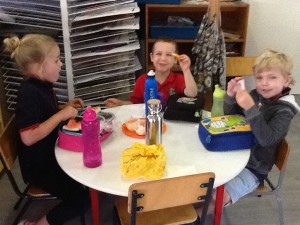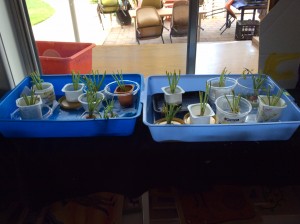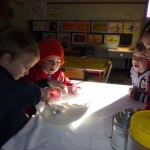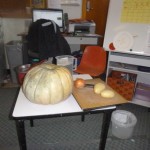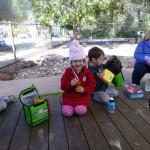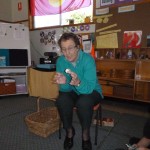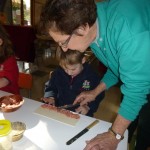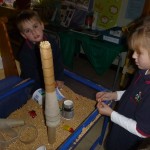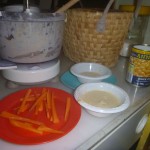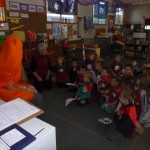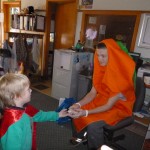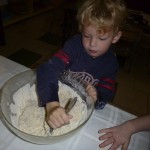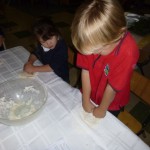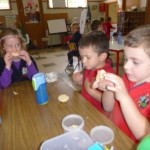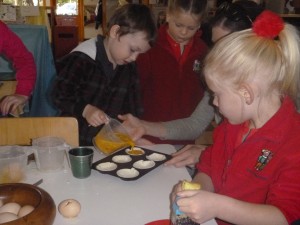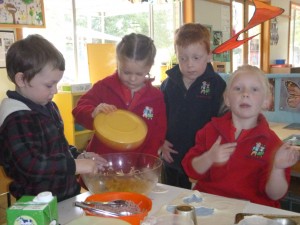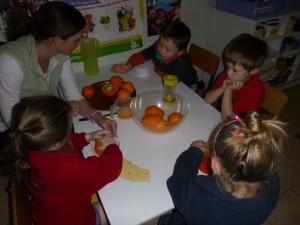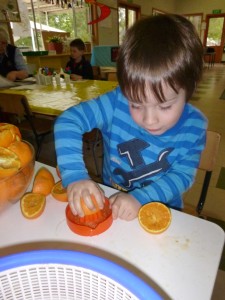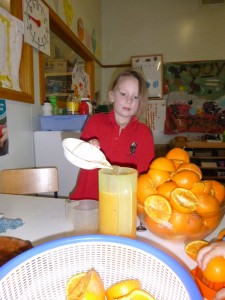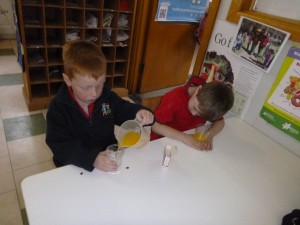We have a new helper for a few weeks, Mie. She is sharing some of her Japanese culture with us. This week we made sushi. The seaweed paper, as the children called it, was a new ingredient for our cooking, and a rather different vegetable! Most of the children didn’t know sushi- except for Blythe, who loves sushi! She recommends avocado but we didn’t have that. Some of the taste testers were not t at all keen on it, whilst others were very happy to eat the spares and everybody else’s too!
Category Archives: Kids cooking
Sushi
At last, our carrots
We have been looking after our carrots for months, it was exciting to finally be able to pull them up and enjoy them! We ate carrot sticks and dip (also celery sticks but they were not as popular.)
Every child had at least a taste, and some didn’t even open their own snack box, they were enjoying the kinder produce so much.
We made good use of the carrot tops, feeding them to the worms, and the chooks, and using some of them to do an experiment. We hope it will work.
damper
We made some damper at kinder to cook on our camp fire. When we had to cancel the bush excursion because of the extreme weather, we shaped our pieces and cooked it in the oven. Minus the ash, smoke, dirt and charcoal, still tasted good!
The children really enjoyed using the damper to shape something special – Claire made a frog, and it stayed together well, so we could still tell what it was.
Pumpkin Soup
When Louise was given a HUGE pumpkin recently, she just had to bring it along to kinder – to make pumpkin soup. Several children have said they eat it at home, and that they like it.
One of the children wondered why it wasn’t orange – was it really a pumpkin?
That’s better.
The soup simmered, it was ready at lunchtime – and then only Meilyn liked it! She came back for seconds, and then thirds… I’m not sure why the others weren’t so keen – but the main thing was that most of them had a taste. (and all the adults enjoyed it!)
A visit from Nana Moyne
A new group of kinder children has learnt how to make sausage rolls with Nana Moyne, and have heard her poem from when she was a little girl – the Fairy poem.
As part of our celebration of the older generation, especially our own grandparents if we are lucky enough to still have them with us and if they live close by, we make sausage rolls to offer our special visitors on the last morning of term.
Learning how to make them from another grandma is extra special – especially as she is one of the best cooks in the district!
Thanks once again, Moyne!
chick pea learning
One of the sorts of seeds Gareth brought in was chickpeas, grown by his mum and dad on their farm. So we planted them….
and used them for pouring and filling and exploring in the trough … (we found out that they bounce).
and we made hummus with them. Nobody in this group had heard of hummus, although they knew about dip.
We looked at, smelt and discussed each ingredient. Tanner looked at the salt, thought it was sugar, and said “we can’t have that here”!!
We surveyed the responses – out of 17 children present, 9 liked it, 6 didn’t like it and 2 wouldn’t try it – but to balance that there were 4 children who LOVED it – we started off dipping carrot sticks and apple wedges, and when we ran out of those, they used pear wedges and banana pieces. Hummus is simple – a can of chickpeas, a little tahini (Sesame seed paste), a dash olive oil, a clove of garlic, half a lemon juiced, pinch salt and maybe a little water, all whizzed together in the food processor. I kept it very mild, but it was still tasty.
Thanks to the farmers who grew all but one of these ingredients.
Together we can be healthy!
Last week we received a reply from Captain Carrot to our invitation that he could come to visit us – he was very busy but suggested sending his cousin Casey Carrot instead – and he came on Thursday.
In readiness we thought some more about what’s healthy to eat – and made badges about fruit and vegetables. We have been practicing our Super Me and the Emu song, both about eating fruit and vegies, and made some Captain Carrot puppets to use. And Thursday morning we made apple triangles, finely chopped apple in a triangle of pastry – no sugar!
Casey helped us to recall the important ways we can be healthy – eating healthy food, drinking water and getting lots of exercise.
And he gave us some power wrist bands – so that “Together we can be healthy!”
Thanks Casey!
making our own food – there’s no app for that!
We have always enjoyed and valued cooking with the children but my visit to Lucknow Kindergarten in Havelock North, New Zealand inspired me to tackle making bread with the children – the old fashioned way, just our hands – no machinery! what a hit!
Children who won’t eat the crusts on their sandwiches cheerfully ate one (or more) pieces of crusty fresh bread buns. Lucknow has deliberately replaced playdough with edible dough experiences as part of their sustainability practices. I respect their thinking about this, although different situations mean that we won’t be baking bread or making pasta every day. I also feel that the field of cooking is too important to limit to dough – but it is lovely to make staple foods like bread with the children – to emphasise that their food does not originate in a plastic bag on a supermarket shelf.
A number of the children commented on how hard it was to squeeze and pinch the dough into a ball – great for fine motor skills and strength development. We know now that movement is essential to brain development, and we have always known the importance of sensory development. There’s no app for that – we have to manipulate and move our bodies to develop our brains.
We hope someone might bring some cereal seeds in next week – like wheat and barley – to further illustrate the important role that farmers play in producing our food.
Eggs and more eggs
We have had some interesting insights into eggs lately – Nana Moyne brought some double yolkers in to show us what they are like inside, and Bailey’s dad downloaded a clip he took on his phone of emu eggs hatching (very special!) Hamish is looking after some eggs in an incubator at home – and therre were the frogs eggs (but the tadpoles died, we don’t know why)
Anyway, lots of children like eating eggs so we decided to do some cooking with eggs for our last day. We made mini quiches with grated zucchini and carrot for extra vegie power.
What did the children learn?
that they could manage every step along the way, with some explanation and demonstration from the adults.
that even if they don’t like quiche they can enjoy the process of using their manual skills
that sharing food is a happy part of being in a group
that you have to be careful when grating…
that you can keep doing something even if it’s hard – and it gets easier.
that our own made food tastes great and that vegies make it more tasty.
“Simply” Squeezing orange juice?
Squeezing orange juice seems such a simple activity and one that at home we have probably relegated to technology with an electric juicer. Like lots of activities that we choose to do more quickly and easily with some sort of electric equipment, when you go back to the fundamentals, it’s a fantastic learning opportunity for young children. Our pre-service teacher, Bree, chose to do this with the children – and so much learning resulted!
The conversations flowed as freely as the juice and everybody contributed!
Put in terms of the EYLF/VEYLDF Learning Outcomes: lots of connections were made to their own orange trees, or someone else’s or buying it in the supermarket, when they drink it, what other juices they like, what else they do with juice (icypoles etc). The children’s sense of identity and family were affirmed, and managing the activity by themselves (with a little help) gave them a great sense of agency and achievement.
The children’s sense of connections with the natural world and with a community of friendly people who share their surplus produce (yes, it does still happen!) was also affirmed. (Bree brought these from her own tree).
Their WellBeing was strengthened by the exercise of twisting with their wrist (a little mantra soon developed “Twist with your wrist” which they chanted as they did it!) and the “incidental” but carefully planned conversations around healthy food, fruit and vegies etc.
Their Learning was enhanced by the opprtunities for hypothesising – how long would it take, how many could they do in a certain time span (they used a timer to help them); and for maths around counting, dividing and estimating. (Some children could confidently, and accurately, predict how many pieces there would be after 2 oranges were cut in half) There was also practical learning – how to get rid of the bits of skin or seeds? a strainer of course. And what can we do with the skins – which Bailey suggested could go to his pigs, so they did.
And then there was the sharing – pouring, making a judgement about how much is “about a half of a glass”? and being aware of fairness in their own and other’s pouring. There was acceptance of mistakes when someone had a spill, and also the need to clean up after a mistake. And finally the drinking – yum!
A final point is one that might get overlooked – the value of offering a LOT of oranges to the children to squeeze meant that nobody had to worry that they wouldn’t get a turn. They could do it more than once, and there was a wonderful sense of abundance which helps us all to feel good.
Thanks Bree! What a fantastic learning experience!
